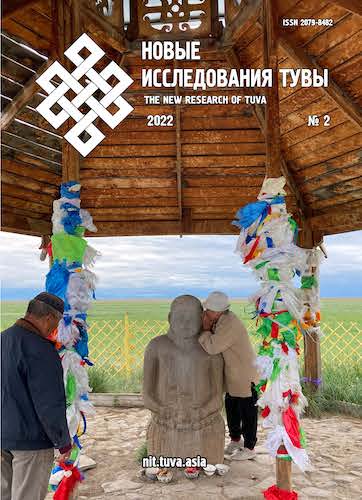Mongolian-Tuvan sector at the Communist University of the Toilers of the East, 1920s–1930s
DOI:
https://doi.org/10.25178/nit.2022.2.15Keywords:
Tuva; Mongolia; Communist International; Communist University of the Toilers of the East; political elitesAbstract
The article examines how citizens of Tuva and Mongolia studied at the Communist University of the Toilers of the East (Kommunisticheskii Universitet Trudyashchikhsia Vostoka, KUTV, Moscow, USSR) in the 1920s and 1930s. To cover their tuition, a specialized Mongolian-Tuvan sector has been set up at the University.
Mongolian students first joined the University in 1922, while their Tuvan counterparts first arrived three years later, in 1925. At first, the Mongolian students were much more numerous, but by 1930 both communities have got more equal in size, with about 200 Tuvans and 250 Mongolians. Student selection was a more or less persistent and goal-directed process, with the majority of students lacking in literacy but members of the Revolutionary Youth Union (Revsomol) or the People’s Party. The intelligentsia-to-be was supposed to appropriate the ideals and values of socialism and spread them among the people in their countries, thus becoming part of their political elites.
Setting up the Momgolian-Tuvan sector was no easy task. Among the known difficulties to overcome were the discrepancies in the levels of education of the students, the absense of learning materials in both languages and the poor command of Russian. Learning plans and syllabi were built to cover 3 or 4 years of tuition — more than in any other “foreign sector” of the KUTV. Teaching days were full of tension for every student, most of whom suffered from learning fatigue and sharp drops in concentration at the end of the term. Many failed to graduate.
On the whole, the sector occupied a special place within the University. The Mongolian and Tuvan students had no need to study under strict secrecy rules. On returning to their home countries after graduation, they could immediately help in state and party building. As a result, when the KUTV split in 1936, the sector remained part of the University where Tuvans and Mongolians studied together with their Soviet counterparts. When the University finally folded in 1938, the sector was subsumed by the Narimanov Institute of Oriental Studies.
References
Aranchyn, Yu. L. (1982) Istoricheskii put' tuvinskogo naroda k sotsializmu [The historical path of the Tuvan people to socialism]. Novosibirsk, Nauka. 337 p. (In Russ.).
Zhabaeva, L. B. (2016) Ob uchastii buriatskoi intelligentsii v demokraticheskikh preobrazovaniiakh v Mongolii [On the role of the Buryat intelligentsia in democratic transformations in Mongolia]. East European Scientific Journal, no. 2, pp. 133–137. (In Russ.).
Mongoliia v dokumentakh Kominterna (1919–1934) [Mongolia in the documents of the Comintern, 1919–1934] (2012) : in 2 parts / ed. by B. V. Bazarov. Ulan-Ude, Izd-vo BNTs SO RAN. Part II (1930–1934). 491 p. (In Russ.).
Osinskii, I. I. and Ul'ziisaikhan D. (1995) Intelligentsiia Mongolii: problemy formirovaniia [The intelligentsia of Mongolia: problems of formation]. Ulan-Ude, Buriatskii gosudarstvennyi universitet. 161 p. (In Russ.).
Firsov, F. (2019) Komintern: pogonia za prizrakom. Pereosmyslenie [Comintern: chasing a ghost. Rethinking]. Moscow, AIRO-XXI. 672 p. (In Russ.).
Kharunov, R. Sh. (2009) Formirovanie intelligentsii v Tuvinskoi Narodnoi Respublike (1921–1944) [The rise of the intelligentsia in the Tuvan People's Republic (1921–1944)]. Abakan, OOO «Zhurnalist». 144 p. (In Russ.).
Kharunov, R. Sh. (2011) Podgotovka spetsialistov sel'skokhoziaistvennogo profilia dlia Tuvinskoi Narodnoi Respubliki v uchebnykh zavedeniiakh Oirotskoi oblasti (1934–1939 gg.) [Training agricultural specialists for the Tuvan People's Republic in educational institutions of the Oirot region, 1934–1939]. Mir nauki, kul'tury, obrazovaniia, no. 5 (30), pp. 271–274. (In Russ.).
Kharunov, R. Sh. (2012) Podgotovka spetsialistov dlia Tuvy na kursakh khoshunnykh rabotnikov v Kommunisticheskom universitete trudiashchikhsia Vostoka (1929–1933 gg.) [Training professionals for Tuvan economy at the courses of khoshun workers at the Communist University of the Toilers of the East (1929–1933)]. Vestnik Tuvinskogo gosudarstvennogo universiteta. Issue 1. Sotsial'no-gumanitarnye nauki, pp. 58–61. (In Russ.).
Kharunov, R. Sh. (2015) Poisk effektivnoi sistemy podgotovki inostrannykh studentov v Kommunisticheskom universitete trudiashchikhsia Vostoka (1920-e gg.) [In search of an effective system of training foreign students at the Communist University of the Toilers of the East (1920s)]. Istoricheskie, filosofskie, politicheskie i iuridicheskie nauki, kul'turologiia i iskusstvovedenie. Voprosy teorii i praktiki, no. 6, in 2 parts, part I, pp. 197–200. (In Russ.).
Khertek, L. K. (2016) Tuvinsko-mongol'skie sviazi i otnosheniia v period Tuvinskoi Narodnoi Respubliki [Tuvan-Mongolian relations under the Tuvan People’s Republic]. New Research of Tuva, no. 3, pp. 65–81. (In Russ.).
Shashkova, O. A. (2018) Kommunisticheskii universitet trudiashchikhsia Vostoka: u istokov doktriny «mirovoi revoliutsii» [Communist University of the Toilers of the East: at the origins of the doctrine of the “world revolution”]. In: 100-letie Velikoi russkoi revoliutsii [100th anniversary of the Great Russian Revolution]. Proceedings of All-Russian research and practical conference / editorial board: I. A. Gataullina, O. M. Gil'mutdinova and D. V. Shmelev. Kazan, KNITU-KAI Publ. 232 p. Pp. 51–58. (In Russ.).
Shashkova, O. A. and Shpakovskaia, M. A. (2018) Kommunisticheskii universitet trudiashchikhsia Vostoka: sozdanie i etapy stanovleniia v sisteme Kominterna v 1920–1930-e gg. [The Communist University of the Toilers of the East (KUTV) and its establishment under the Comintern in the 1920s and 1930s]. Vestnik arkhivista, no. 3, pp. 704–716. (In Russ.). DOI: https://www.doi.org/10.28995/2073-0101-2018-3-704-716
Published
How to Cite
For citation:
Kharunov R. Sh. and Kharunova M. M.-B. Mongolo-tuvinskii sektor Kommunisticheskogo universiteta trudiashchikhsia Vostoka (1920–1930-e gg.) [Mongolian-Tuvan sector at the Communist University of the Toilers of the East, 1920s–1930s]. New Research of Tuva, 2022, no. 2, pp. 211-223. (In Russ.). DOI: https://www.doi.org/10.25178/nit.2022.2.15
Issue
Section

This work is licensed under a Creative Commons Attribution-NonCommercial 4.0 International License.

Author(s) license holder(s) grant rights for their work to the journal (grantee of a license) under the simple non-exclusive open license in accordance with Art. 1286.1 «Open license for a research work, work of literature or fine arts», Civil Code of the Russian Federation.
New Research of Tuva publishes articles under the Creative Commons Attribution-NonCommercial license (CC BY-NC).
Since it is an open license, author(s) reserve the right to upload the article to their institutional repository, submit it to another journal (if it allows republications), or republish it on their own website (in full, or in part).
However, several conditions apply here:
a) The republished version must always contain the name(s) and affiliation(s) of the author(s), the original title and the hyperlink to the original version on the New Research of Tuva website;
b) It must be in open access, free of charge, and no category of readers must be in any way whatsoever advantaged over general readership.
c) should the contribution be submitted elsewhere by its author(s) without substantial modification (30% or more of original text unchanged), the body of the article should contain a disclaimer that the original version was published in New Research of Tuva (with a link to the respective page)
The CC-BY-NC is a non-revocable license which applies worldwide and lasts for the duration of the work’s copyright.










